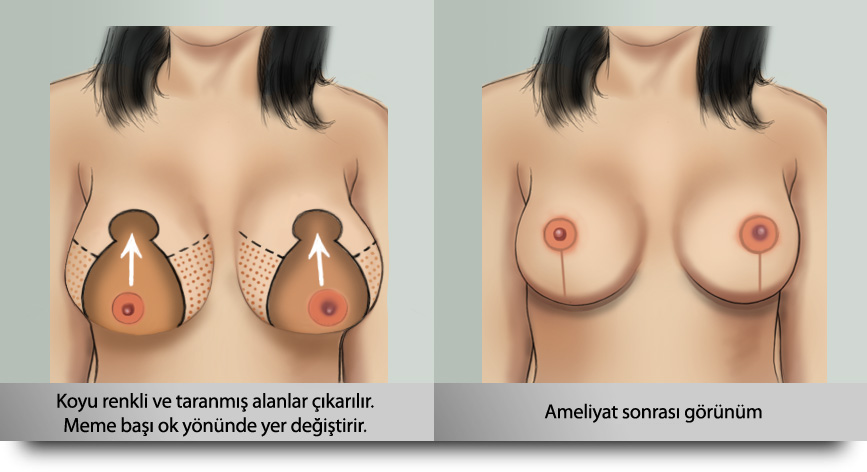
What is Breast Reduction Surgery?
Breast reduction surgery or reduction mammoplasty as it is called in medicine is an operation performed due to aesthetic concerns or medical problems. The aim of breast reduction surgery is to obtain an equal, symmetrical, aesthetic breast that will not affect the patient’s life, with the least possible stitch scars.
Negative problems caused by large breasts are sagging, not looking good, not being symmetrical, and shoulder, neck, back pain and hunching.
How is Breast Reduction Surgery performed?
Breast reduction surgery is performed using lollipop incision and reverse T incision methods. For the surgery, the method is first determined and then the surgery is started. Breast size, position of the nipple relative to the breast crease, breast tissue, skin structure, distance between the nipple and shoulder and hip are important criteria in determining the method.
If it is decided to perform the surgery with the lollipop incision method, the area around the nipple is cut circularly and excess breast tissue and skin tissue are removed. In order not to damage the mammary glands, the breast tissue is carefully closed and a drain is placed to remove the bleeding that occurs inside. This is how the surgery ends.
If it is decided to perform the surgery with the reverse T incision method, an incision in the form of an inverted T letter is made from the lower part of the breast. Excess breast tissue and skin tissue are removed and the surgery is terminated as in the lollipop method. Breast reduction surgery, which lasts between 2.5 and 4 hours on average, is performed under general anesthesia.
After breast reduction surgery, the patient should stay in the hospital for one night in order to keep the patient under observation.
On the next day of the surgery, the surgical area is dressed and the drain is removed and if no complication is observed, the patient is discharged.
Who can have Breast Reduction Surgery?
Breast reduction surgery can be performed on people who have shoulder, neck and back pain due to their breasts being larger than normal, who have fungus and rash problems in their breasts, who complain about their aesthetic appearance, and who have an asymmetrical appearance in the breast.
What is the preparation process for Breast Reduction Surgery?
The preparation process for breast reduction surgery consists of physical examination, patient information and education, and planning before breast reduction surgery. During the physical examination, the patient’s medical history is taken and the patient’s suitability for surgery is decided. Patient information and education is the important part where information is given about what the patient will do before and after the surgery and what to pay attention to.
In the planning stage, it is decided how much the patient’s breast should be reduced and which method will be applied.

What is the recovery process of Breast Reduction Surgery?
It is very important for the successful outcome of the surgery after breast reduction surgery. After the operation, if the patient follows the simple rules and pays attention to the care of the operation area, the recovery process will be easier.
In order to avoid bleeding and infection after breast reduction surgery, the patient should not consume herbal products, alcohol and cigarettes.
Medications given by the doctor should be used regularly, clean care should be provided, dressing and hygiene rules should be followed. In order to avoid bleeding, the patient should avoid sudden movements.
What should be considered after Breast Reduction Surgery?
In the first and second weeks after the operation, control examinations called by the doctor should be performed.
In the control examination performed in the second week after the operation, the sutures are removed and the scar treatment is started in order to prevent the operation scars. Scar creams specially recommended by the doctor are used.
After the operation, the patient should rest at home for a week by wearing a non-squeezing surgical corset that is compatible with the size of the breast, and a bra should be worn for six weeks. At the end of a week, she can return to her daily life. At the end of six weeks, she can start wearing a normal bra.
It is normal to feel tenderness, stinging and tingling in the breasts during the first 6-12 months after breast reduction surgery. These problems do not affect the social life of the patient, and they go away by resting.
Forceful movements on the arm and chest areas should be avoided.
After the surgery, you should rest at home for at least three and at most seven days.
At the end of the first week, light walks can be started.
Especially during the first month should not lie face down.
Carrying heavy objects and doing heavy physical activity should be avoided for the first four weeks after the surgery.
You should definitely not take a shower in the first four days after the surgery, and you can take a shower after the fourth day.
Medicines prescribed by the doctor should be used, and no other medicine should be used.
The first 1.5 months after breast reduction surgery is an important process for the successful outcome of the surgery.
Frequently asked questions about Breast Reduction Surgery
Will there be any scars after Breast Reduction Surgery?
Surgical scar after breast reduction surgery is an expected situation and the doctor will inform the patient about this issue. The shape and size of the scar varies depending on the surgical method.
If the surgery is performed with the lollipop method, the scar is less, while it is larger when it is performed with the reverse T method. The reason for this is that the amount of incision is less in the lollipop method and the incision is at the nipple.
In the reverse T method, the incision is downwards from the nipple. The size of the surgical scar also depends on the sagging condition of the breast and how much the patient wants to reduce it.
What are the risks and complications after Breast Reduction Surgery?
Side effects and complications that may occur after breast reduction surgery may vary completely depending on the patient. The most common side effects of this surgery are bleeding and infection. Although serious bleeding is not expected at the end of the surgery, a slight bleeding may be experienced.
If there are blood thinners among the drugs used frequently before the surgery, they should be transferred to the doctor. In addition, since the use of alcohol, cigarettes and herbal products may increase bleeding, they should not be consumed for a while. When breast reduction surgery is performed in the operating room, under sterile conditions and by specialists, the risk of infection will decrease. Another factor that increases the risk of infection is improper and unclean care.
The risk of infection will decrease when the patient cares after the surgery as recommended by the doctor and uses the medications prescribed by the doctor regularly. A complication that may occur after breast reduction surgery is hematoma. Hematoma refers to the accumulation of bleeding at the edge of the breast. In case of hematoma, the patient may need a second surgery.
It is normal to see edema in the breasts after breast reduction surgery, but the doctor should be informed as swelling that does not go away after five days may be a sign of infection. Apart from these complications, another very rare complication is skin loss.
Although skin loss is more common in smokers, it is a common complication. This complication may require dressing or a second surgery. Wound healing delays will be prevented by dressing the surgical area and with a clean care. The last complication of this surgery is the problem of asymmetry in the breasts.
Is it possible to breastfeed after Breast Reduction Surgery?
In breast reduction surgery, if no intervention was made to the nipple, milk ducts and milk glands during the operation, it can be breastfed after the operation.
Since breast reduction surgery usually does not interfere with the nipple, milk ducts and milk glands, people who are considering having this surgery should not worry about breastfeeding after the surgery.







